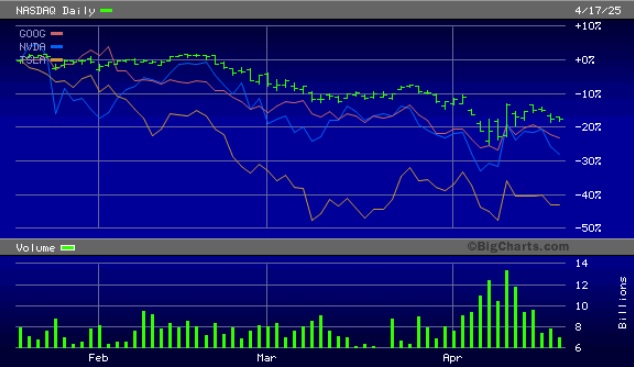By Pam Martens and Russ Martens: April 21, 2025 ~
The clown show in Washington should not divert your gaze from the circus at the Nasdaq stock market.
On January 20, 2025, the day that Donald Trump was sworn into office for his second term as President, the stock market was closed in honor of Martin Luther King Jr. Day. On January 21, 2025, Trump’s first full day in office, the Nasdaq stock market closed at 19,756.7793. On Thursday, April 17, 2025 – the final day of trading last week because the stock market was closed for Good Friday on April 18 – the Nasdaq closed at 16,286.4476 – bringing its losses during Trump’s new reign in the White House to 3,470.3317 points or 17.57 percent. (The data comes from Dow Jones’ BigCharts.MarketWatch.com.)
There are legitimate questions now being raised as to whether we’re in a tech bubble that’s going to burst in a replay of the disastrous dot-com bust of 2000 to 2002. Last year, we wrote as follows about that period:
The Nasdaq reached a closing high of 5,048.62 on March 10, 2000. The Nasdaq then proceeded to lose 78 percent of its value over the next 2-1/2 years, reaching a closing low of 1,114.11 on October 9, 2002.
As late as February 2000, there was little recognition in mainstream media that the Nasdaq was on the cusp of entering one of the bloodiest selloffs in stock market history. CNNMoney reported as follows on February 29, 2000:
“U.S. stocks rallied broadly Tuesday, sending every major market gauge higher and the Nasdaq composite index to its 12th record close of the year as investors snapped up technology shares expected to lead the economy’s growth.”
The same news report quoted Legg Mason’s Chief Market Strategist at the time, Richard Cripps, as follows: “People want to own these (technology) stocks, and that’s what limits any significant drop on these stocks and it’s what puts pressure on the remainder of the market.”
Less than two weeks later, investors began the stampede out of the market darlings.
In 2017, the legendary investor, Warren Buffett, CEO of Berkshire Hathaway, penned his annual letter to shareholders. In it, he opined as follows:
“Above all, it’s our market system – an economic traffic cop ably directing capital, brains and labor – that has created America’s abundance. This system has also been the primary factor in allocating rewards.”
Unfortunately, Buffet was reflecting a nostalgic yearning for how he wished the U.S. markets still worked. He was not providing a genuine assessment of how U.S. markets are actually functioning.
In fact, federal regulators turning a blind eye to market rigging has made the exact opposite of Buffett’s analysis the true reality. The stock market has become a blindfolded traffic cop, misallocating capital, brains and labor. And a whole platoon of crooked and blindfolded market cops have replaced the market’s efficient pricing mechanism with Dark Pools and trading platforms hiding out in the shadows in the U.S. and abroad. (See JPMorgan Chase and Its Regulators Are Hiding Dark Trading Secrets at the Largest and Riskiest U.S. Bank; or Citigroup Ran a Secret, Unregistered Stock Exchange for More than Three Years; or Goldman Sachs Is Quietly Trading Stocks In Its Own Dark Pools on 4 Continents; or Wall Street Banks Are Trading in Their Own Company’s Stock: How Is This Legal?)
What fueled the dot-com boom were corrupt research reports from the major trading houses on Wall Street, which urged investors to “buy” while the same research analysts were internally calling the stocks “crap.”
On April 28, 2003, the Securities and Exchange Commission settled its cases against the corrupt research practices with 10 Wall Street banks for $875 million. Investors lost more than $4 trillion but Wall Street got off with a payment of $875 million. No one went to jail. Just two individual analysts were charged: Jack Grubman of Citigroup’s former Salomon Smith Barney unit and Merrill Lynch’s Henry Blodget. Both men were barred from future affiliation with a broker-dealer and paid fines that were a fraction of the bonuses they had collected from their firms.
The same Wall Street banks that settled with the SEC in 2003 have continued to be allowed to issue research reports on companies for whom they underwrite stock and debt offerings. In addition, they are allowed by the SEC to trade these same stocks in their own Dark Pools, which are, effectively, unregulated stock exchanges that reside inside the banks. Among the banks that were fined in 2003 by the SEC and are operating Dark Pools today are: JPMorgan, Goldman Sachs, Citigroup, Morgan Stanley and Merrill Lynch.
While many Wall Street stockbrokers are likely to urge their clients to buy the dips or at least stay put and ride out the tech market storm (since many are paid a fee based on their amount of assets under management), the reality is that it can take a very long time to get back to even after a major market bust.
After the dot-com bust, the Nasdaq was so discredited that it did not reset its March 2000 high until 15 years later. In fact, it remained 50 percent or more below that high until 2007. After the 1929 stock market crash, the stock market did not set a new high until 25 years later.
A new report out from InvestorsObserver.com reminds us that “Microsoft took 17 years to recover from the dot-com crash” and the report asks if history will repeat for artificial intelligence (AI) stocks. The report alarmingly notes that “The S&P 500’s top 10 companies now make up 33% of the index’s total market capitalization – one of the highest levels on record.”
Cisco, another darling of the dot-com era, reached a high of $80.06 on March 27, 2000. It’s now a quarter of a century later and Cisco has not set a new high. Buying at market tops can, indeed, be hazardous to your wealth.
